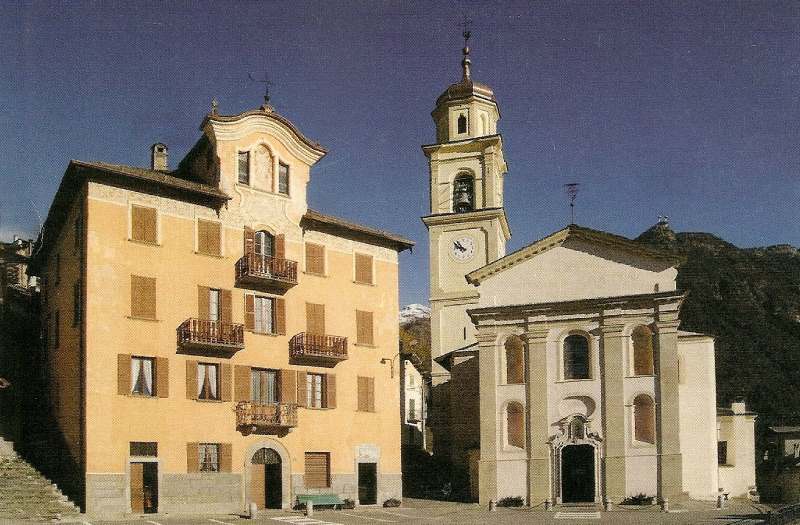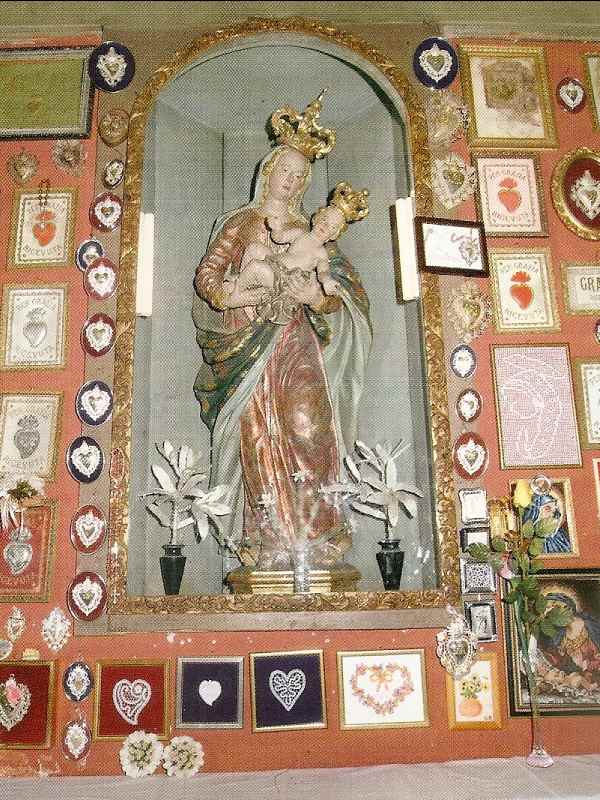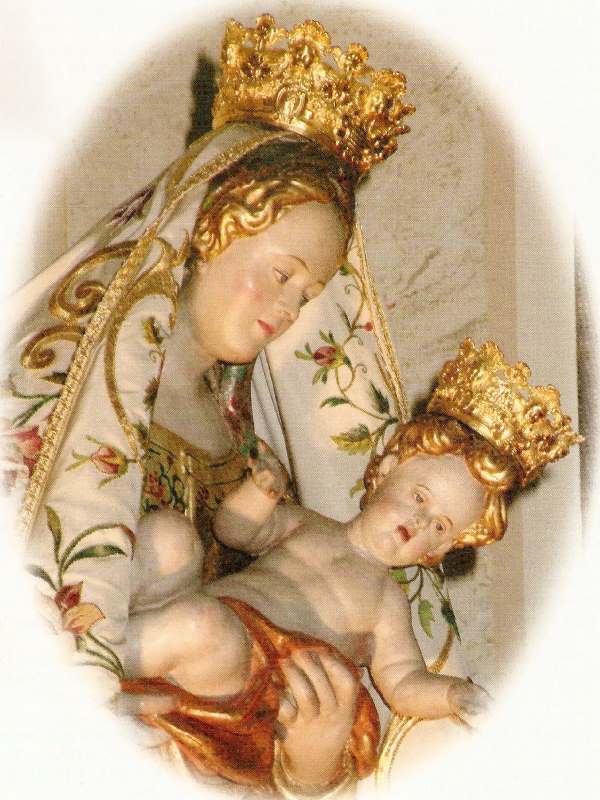by Saveria Masa
Built in the second half of the seventeenth century, the Sanctuary of the Beata Vergine delle Grazie in Primolo was, and still is a destination of pilgimage and place of devotion not only for the people of the valley.
The building stands in a splendid panoramic position, as it was built on a hill overlooking the basin of
Chiesa Valmalenco.
Below, you can see the villages of
Lanzada and
Caspoggio, and if you look upwards,
Pizzo Scalino stands out against the sky, a natural sanctuary in a landscape of absolute beauty.
 Santuary of the Madonna delle Grazie di Primolo.
Santuary of the Madonna delle Grazie di Primolo.
The Sanctuary was built in 1688: on 4 August that year they laid the first stone and within a very few years, the church was completed and immediately officiated.
The path towards its construction was, however, very long and troubled.
The idea of building a church in Primolo was first put forward by the district supporters, who wanted to build a church for their own spiritual needs.
They were in an extremely inconvenient situation, especially in the winter months, as they had to go to Chiesa every time for mass, funerals and baptisms.
 The Crowned Madonna.
The Crowned Madonna.
Whereas the people of Primolo would have liked to build a simple church, large enough for the population of the district, and place it in the area known as Pratoni above the village, the parish priest, Giovanni Chiesa, had more ambitious aims and wanted to erect a santuary dedicated to the Madonna delle Grazie.
It was to be positioned so that it was clearly visible from the entire Valley, and would become a place of pilgrimage and Marian devotion.
The failure of the priest and the people of Primolo to come to an agreement meant that many years would pass without any result until the parish priest in his old age was able to convince the people of Primolo to construct the sanctuary he wanted.
An eighteenth century source tells us he believed the Madonna had appeared to him in a dream ordering him to build a samtuary in her honour right in the place he wanted to build it.
The elderly priest played a major role in the construction of the church, as he was the first to have the idea.
However, his nephew, Giovanni Maria Chiesa, was appointed parish priest of Chiesa following the death of his uncle just two days after the first stone of the sanctuary was laid.
He was the one to effectively see this project through.
Both priests belonged to the wealthiest family in the Valmalenco, the Chiesa family, which boasted a centuries-old tradition of notaries and clergy and throughout the seventeenth century had gradually risen up the social ladder to become the undoubted protagonist of the political and religious life of the Valley.
During the eighteenth century, the sanctuary became one of the most devote Marian strongholds of the Valtellina, to the extent that, in 1765, it received major recognition from the Vatican Chapter with the crowning of the statue of the Madonna.
At that time, this privilege was granted only to the most important sanctuaries of the province.
These included the sancturary of the Madonna of Tirano and that of the Madonna of Gallivaggio.
To celebrate the solemn rite of the coronation, Pope Clement XIII appointed the abbot of the monastery of Disentis in the Grigioni Canton, Colombano Sozzi, who was also Prince of the Holy Roman Empire.
The ceremony was held in Chiesa on 11 August 1765 in the presence of the abbot, the bishop of Como, Giovan Battista Mugiasca, and all the clergy of the Valley.
From the early years of its construction, the sanctuary soon became the destination of devotion and pilgrimage with a constant flow of believers from nearby villages.
It was considered above all a place to implore the grace and protection of the Virgin Mary, as some of the very old votive tablets continue to testify today.
 The Madonna with Child.
The Madonna with Child.
The custom of celebrating the feast of the sanctuary was soon established on the first Sunday in August.
The traditional procession with the statue of the Madonna through the village streets is also believed to have begun at the same time the sanctuary was built.
The evening before, they would light a large number of night bonfires on the Alpine pastures of the Valley.
This tradition was not only a moment of communal festivity, but also a sign of devotion to the Madonna of Primolo, who the people of the Valmalenco felt to be ""their" Madonna.
Over the three centuries of existence of the sanctuary, devotion to the Madonna of Primolo became a fundamental tradition, in which elements of sacredness combined with more orthodox, picturesque aspects of folklore.
This is the case of the well-known tradition of "scratching glass" by women seeking a husband.
The glass in question is obviously the glass of the niche holding the statue of the Madonna.
This is a more recent tradition, mainly linked to popular ideas typical of the late nineteenth century, a period in which advertising material introducing the Alpine villages to the first tourists began to flourish.